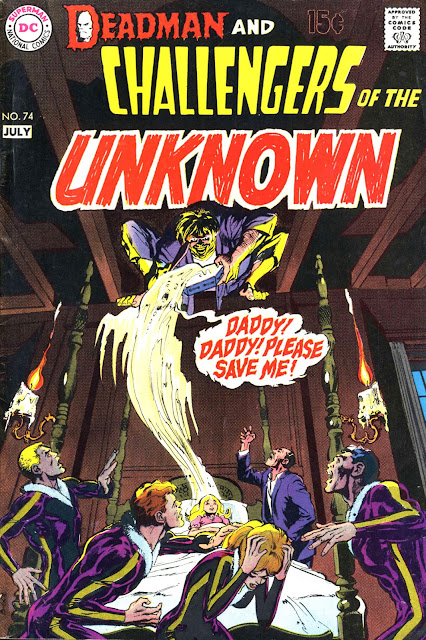House of Secrets #86 July 1970
'At Midnight the puppet cried! WHY?'
A couple of kids descend the staircase to find a defeated-looking old man asleep in a chair. In his left arm he is cradling a puppet with bright pink hair and tears rolling down its pink cheeks while a dog sniffs curiously at his feet.
The Neal Adams cover image relates to THE BALLAD OF LITTLE JOE, one of three strips (and one text story) contained in DC's HOUSE OF SECRETS #86, dated July 1970. The tale is a dark SF retelling of the Pinocchio story written by Gerry Conway with art by Bill Draut (credited as Big Bad Bill), the duo behind the framing sequence in the comic.
The opening page, a wordless five-panel zoom-in from a wood to a house to a puppet lying on the floor is comics storytelling at its simplest - and most effective. The idea of the puppet crying, though perhaps hackneyed to modern readers, would I'm sure have been a less familiar trope to the youthful audience of 1970. I must admit my personal response to the whole page was "Wow...!"
A lonely old man, his family all dead apart from an unsympathetic grown-up daughter, finds solace in making puppets. The daughter is particularly hard-nosed, threatening to have her father "put away". It's only the old man's (spoiler! spoiler!) DEATH that prompts her change of heart and in a neat conclusion the tears now fall from her eyes not the puppet's.
To be fair it's not a great story. The SF interlude in which a pair of aliens living "beneath the Earth's crust" purloin the puppet and bring it to life in a bizarre attempt to take over the world is at odds with the setting and mood of the rest of the narrative.
Still, the art adds sufficient poignancy in the right places despite the absurd sight of the bald-headed bewhiskered aliens.
Follow @top_notch_toshThe framing story allows us to witness Abel reacting emotionally to the story. It's a nice touch, assisting readers to feel comfortable with their own feelings reading a narrative which doesn't necessarily end in a comforting way.
Also in this issue is STRAIN, the sort of story which involves a lot of build-up and very little pay-off, though the ghostly image of the murdered Martha playing piano stays in the memory afterwards.
Written and drawn by George Tuska, it sadly ends in the most unforgivable way...!
George Tuska's art is relatively new to me, something about the ghostly image of Martha reminded me of Evie from V FOR VENDETTA, in fact at several points in this story I was prompted to think about David Lloyd's work.
The issue also features letters addressed to the House itself, an entity which has its own acerbic manner of reponding. Here's just a flavour...
The final story THE DAY AFTER DOOMSDAY is an apocalyptic two-page quickie in which artist Jack Sparling confidently suggests humanity will survive extinction because of a couple who physically seem to come straight out of Hitler's Aryan playbook. Now there's a chilling thought for you...














Comments
Post a Comment